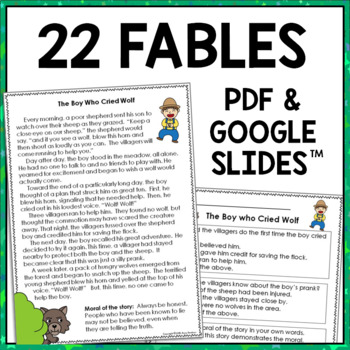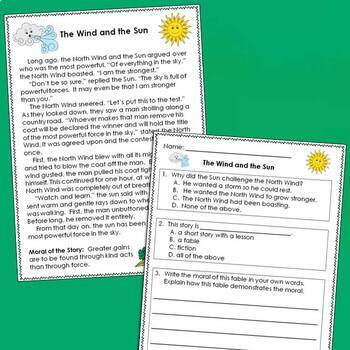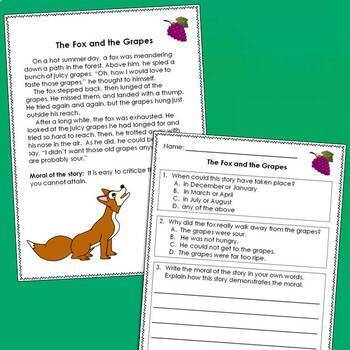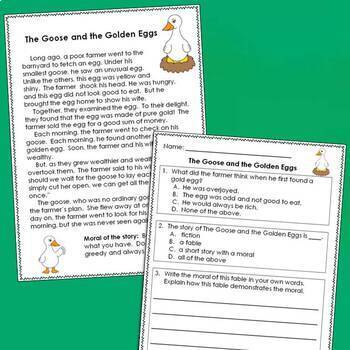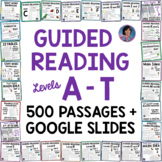Aesop's Fables with Comprehension Questions: 1st & 2nd Grade Reading Passages
- PDF
- Internet Activities
- Easel Activity
What educators are saying
Also included in
- These Reading Comprehension Passages and Questions for Kindergarten through Third Grade (Guided Reading Levels C through P and DRA Levels 3 through 38) are designed to help students learn to read carefully and to find evidence to support their answers to text-based questions. Make differentiationPrice $55.00Original Price $108.74Save $53.74
- Kindergarten - Fourth Grade Reading Passages & Questions for Guided Reading Levels A-T: Also Available Separately! This bundle, which includes 500 reading passages with questions, is designed to help students develop strong comprehension skills.To provide flexibility, for use in distance learninPrice $99.00Original Price $228.48Save $129.48
Description
Fables are always a favorite with my students! This file includes 22 fables. For ease of use, each fable is presented on a single page. The fables are presented in order of increasing text complexity, ranging from Guided Reading Level I through Guided Reading Level K (DRA Levels 16 - 24).
To provide flexibility, for use in distance learning and/or a classroom setting, the following options are offered:
1) A link to this document in Google Slides
2) Ready for use with the new TpT Digital Tool
4) Printable, as a traditional PDF
With each fable, there is a page of text-dependent questions consisting of two multiple choice questions and one written response question. The written response question remains consistent throughout the pack: Write the moral of this fable in your own words. Explain how this story demonstrates the moral.
The topics provide rich opportunities for discussions regarding character traits and social emotional learning.
Five graphic organizers that can be used interchangeably with any of the fables are also included.
The following fables are included:
★ The Ant and the Dove
★ The Boy Who Cried Wolf
★ The Farmer and His Sons
★ The Lion and the Oxen
★ The Fox in the Well
★ The Goose and the Golden Eggs
★ The Man, His Son and the Donkey
★ The Frogs and the Well
★ The Wind and the Sun
★ The Shepherd and the Wild Goats
★ The Cat, the Rooster and the Mouse
★ The Peasant and the Eagle
★ The Crows and the Pitcher
★ The Young and the Old
★ The Crowded Cottage
★ The Rooster and the Fox
★ The Fox and the Grapes
★ The Rooster and the Jewel
★ The Sickly Lion
★ The Fox and the Crow
★ The Peacock's Tail
★ The Miser and His Gold
For use as a printable resource, a PDF file is available for immediate download.
For online/digital use, this resource is aligned with the new Tpt Digital Tool, through which selected pages can be assigned using Google Classroom.
This resource was designed to support the following Student Outcomes and related Common Core Standards:
★ Students will read with sufficient accuracy and fluency to support comprehension (RF.1.4 and RF.2.4).
★ Students will determine the central message, lesson, or moral of stories, including fables and folktales from diverse cultures (RL.2.2).
★ Students will read common high-frequency words and grade-appropriate irregularly spelled words (RF.K.3c, RF.1.3g and RF.2.3.F).
These fables are appropriate to read to students in kindergarten. Some first grade students are able to read these toward the end of the year, while others benefit from following along as these fables are read aloud.
These are appropriate independent reading for students reading at a second or third grade level.
Thanks so much for stopping by and taking a look!
Sincerely, Anne Gardner (NBCT, Literacy)
******************************************************************************************************************************************
Please Note: An answer key is included for the multiple choice questions. For many of the written response questions, answers can vary and are considered correct as long as the student logically uses evidence from the text to support his or her answer.
Also Known As: Aesop's Fables & Questions: Guided Reading Levels I - L {PDF and Digital Option}

